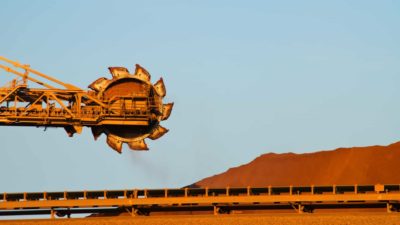The S&P/ASX 200 Index (ASX: XJO) iron ore giants all reported their financial results for 2021 (FY21) last month.
How their share prices have moved since reporting is important not just to investors in the big miners. It also impacts anyone investing in an ASX 200-tracking exchange-traded fund (ETF).
That's because, when taken together, BHP Group Ltd (ASX: BHP), Rio Tinto Limited (ASX: RIO), and Fortescue Metals Group Limited (ASX: FMG) have enough firepower to help or hinder the broader index.
Below we look at a brief recap of the key results these 3 ASX 200 iron ore titans reported, as well as how they've been performing since.
One thing to keep in mind when looking at their performance is the sliding price of iron ore. On 17 August iron ore was trading for US$167 per tonne, according to data from Markets Insider. Today that same tonne is trading for US$129. That's 23% lower in less than 1 month.
Go back just a few weeks further, to 30 July, and iron ore was trading at US$212 per tonne.
With that said…
How has BHP performed since reporting results?
BHP reported its FY21 results after market close on 17 August.
The core results included a 69% increase in underlying earnings before interest, taxes, depreciation, and amortisation (EBITDA) to US$37.4 billion.
The miner's underlying attributable profit also leapt by 88% to US$17.1 billion, while net operating cash flow increased by 73% to US$27.2 billion.
The strong results enabled BHP to declare a final dividend of US$2.00 per share, fully franked. The full-year dividend of US$3.01 per share represented a 151% increase on FY20.
BHP also reported on its pending merger deal with Woodside Petroleum Limited (ASX: WPL).
ASX 200 investors would have had this data on hand at market open on 18 August. Despite the strong results, the BHP share price fell 7% on the day.
Though shares are edging higher today, they're currently down 19% since BHP released its FY21 results.
And what about Fortescue?
Fortescue reported its FY21 results on 30 August.
The key metrics included a 74% leap in total revenue for the ASX 200 miner. Revenues hit US$22.3 billion, up from US$12.8 billion in FY20.
EBITDA also surged by 96%, to US$16.4 billion, compared to US$8.4 billion the prior year. This helped drive a 117% increase in net profit after tax (NPAT) to US$10.3 billion, up from US$4.7 billion in FY20.
Fortescue boosted its final dividend to $2.11 per share. The full-year dividend of $3.58 per share was up 103% year-on-year.
ASX 200 investors were clearly buoyed by the results, which saw the Fortescue share price gain 7% on the day.
But things have largely gone the other direction since then. Fortescue shares are down 1.79% in intraday trading today, and down 15% since the miner released its results.
How has ASX 200 miner Rio performed?
Unlike its 2 major ASX 200 rivals above, Rio released half-year results, not full year.
The results for the 6 months ending 30 June were released after market close on 28 July.
On the back of surging iron ore prices (which as mentioned above have since been in retreat), Rio reported a 71% increase in consolidated sales revenue from the prior corresponding half year, up to US$33.1 billion.
The miner's free cash flow increased by an impressive 262% over the corresponding period, to US$10.2 billion.
All that cash saw Rio declare an interim dividend of $3.76 per share, fully franked, plus a fully franked special dividend of US$1.85 per share.
ASX 200 investors would have had time to pore over these results before market open on 29 July. And they appear to have liked what they read, sending the Rio share price up 1.5% on the day.
As with the other ASX 200 mining titans, Rio's share price has come under pressure since then. Shares are down 19% since reporting its half-year results.









